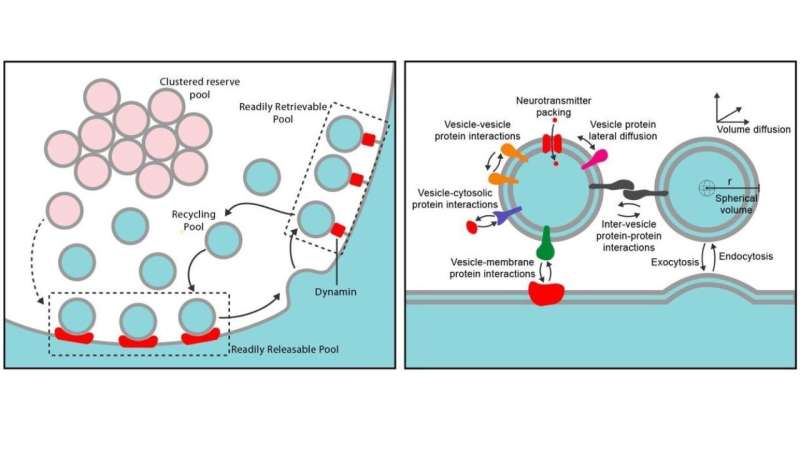How do we think, feel, remember, or move? These processes involve synaptic transmission, in which chemical signals are transmitted between nerve cells using molecular containers called vesicles. Now, researchers have successfully modeled the vesicle cycle in unprecedented detail, revealing new information about the way our brain functions.
A joint study, published in Science Advances, between researchers at the Okinawa Institute of Science and Technology (OIST), Japan, and the University Medical Center Göttingen (UMG), Germany, has applied a unique computational modeling system, which considers the complicated interplay of vesicles, their cellular environments, activities and interactions, to create a realistic picture of how vesicles support synaptic transmission.
Their model predicts parameters of synaptic function that could not be tested experimentally in the past, opening new avenues in neuroscience investigations.
“Recent technological advances have enabled experimental scientists to capture increasing amounts of data. The challenge now lies in integrating and interpreting all the different types of data, to understand the complexities of the brain,” said Professor Erik De Schutter, head of the OIST Computational Neuroscience Unit and co-author of the study.
“Our model provides better molecular and spatial detail of the vesicle cycle, and much faster than any other system before. And it’s transferable to different cells and scenarios too. It’s a significant leap forward towards scientific aspirations of full cell and full tissue simulation.”
“We have been working on synapses for over 20 years, but some functional steps were difficult to test experimentally. After several years of fine-tuning experimental and computational work with our Japanese colleagues, we now have a model for testing new hypotheses, especially in the context of neurological diseases,” added Professor Silvio Rizzoli, director of the Department for Neuro- and Sensory Physiology at the UMG and also co-author on the study.
What is the synaptic vesicle cycle?
The vesicle cycle describes the steps through which neurotransmitters (chemical signals) are released at a synapse (a junction between nerve cells), to transfer information between cells.
Vesicles containing neurotransmitters move and dock at the membrane, ready to fuse and release their contents, before being recycled. The process is prompted by electrical stimulation within the brain and is driven by a complex signaling cascade.
Depending on the situation, different amounts of neurotransmitters need to be released over different time periods. To enable controlled and sustained synaptic transmission, only 10–20% of vesicles are readily available to dock at any given time (these are known as the recycling pool). Most vesicles are instead in a reserve pool, immobilized in a cluster.
Many details of this process, including how vesicles move between the reserve and recycling pool, were poorly known.

The mechanisms of vesicle recycling at high stimulation frequency
In their publication, the researchers shed new light on the vesicle recycling process in hippocampal synapses. With their model, they aimed to both confirm the behavior of vesicles at experimentally-observed firing frequencies, and explore behavior at higher frequencies.
They discovered that the vesicle cycle was able to operate at high stimulation frequencies, far beyond what is normally found in nature. They were also able to pinpoint some of the reasons behind this robust cycle, identifying the roles of key proteins synapsin-1 and tomosyn-1 in regulating vesicle release from the clustered reserve pool.
The researchers note that the efficiency of the vesicle cycle relied on molecular tethering. By physically connecting some vesicles to the membrane with tethers, a close supply of vesicles could be made available for rapid docking and neurotransmitter release.
These important findings enable a deeper understanding of vesicle recycling, a process involved in many different diseases.
“For example, the release of neurotransmitters is hampered in botulism or some myasthenic syndromes. Treatments for depression and other major neurological diseases also often focus on synaptic transmission,” explained Prof. De Schutter.
“As we expand our models, the potential applications are vast, both in developing new therapeutics, and in deepening our fundamental understanding of how the brain works.”
More information:
Andrew Gallimore et al, Dynamic Regulation of Vesicle Pools in a Detailed Spatial Model of the Complete Synaptic Vesicle Cycle, Science Advances (2025). DOI: 10.1126/sciadv.adq6477. www.science.org/doi/10.1126/sciadv.adq6477
Okinawa Institute of Science and Technology
Citation:
Vesicle cycle model reveals inner workings of brain synapse (2025, May 28)
retrieved 28 May 2025
from https://medicalxpress.com/news/2025-05-vesicle-reveals-brain-synapse.html
This document is subject to copyright. Apart from any fair dealing for the purpose of private study or research, no
part may be reproduced without the written permission. The content is provided for information purposes only.


